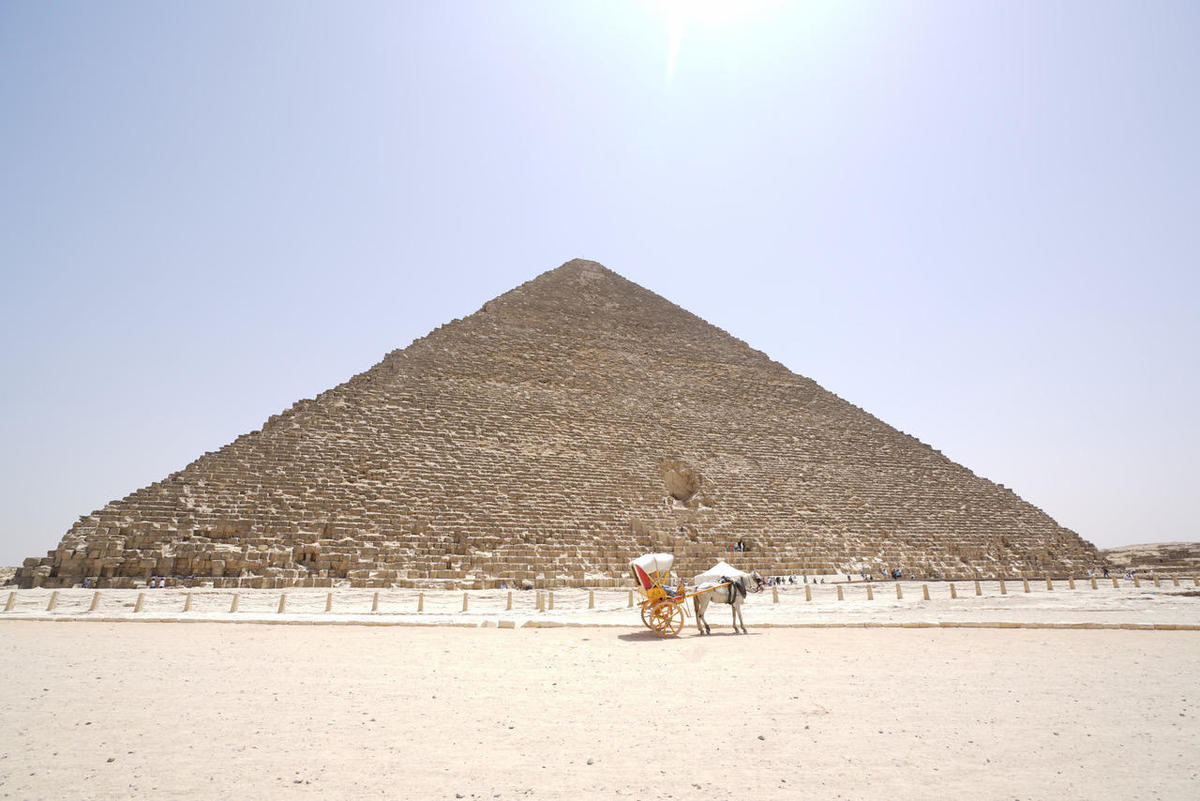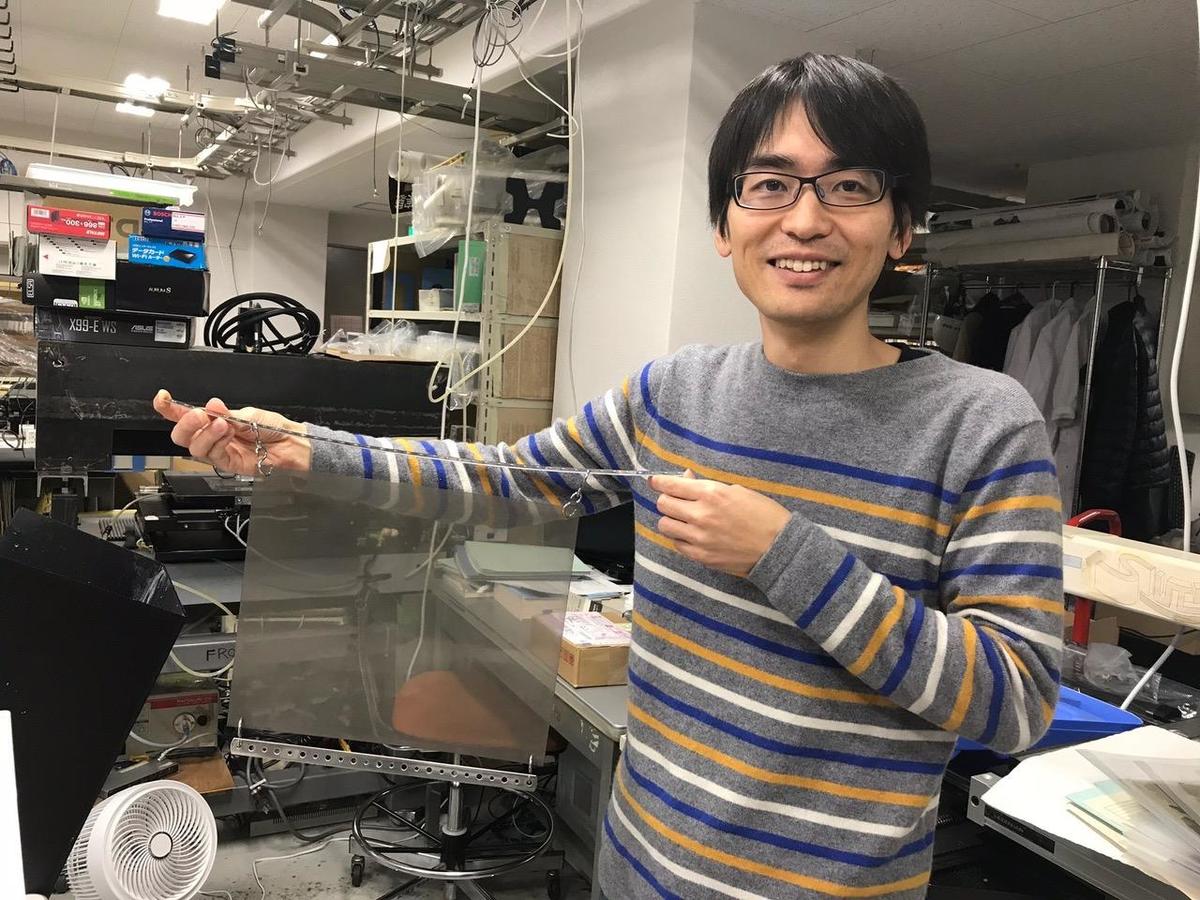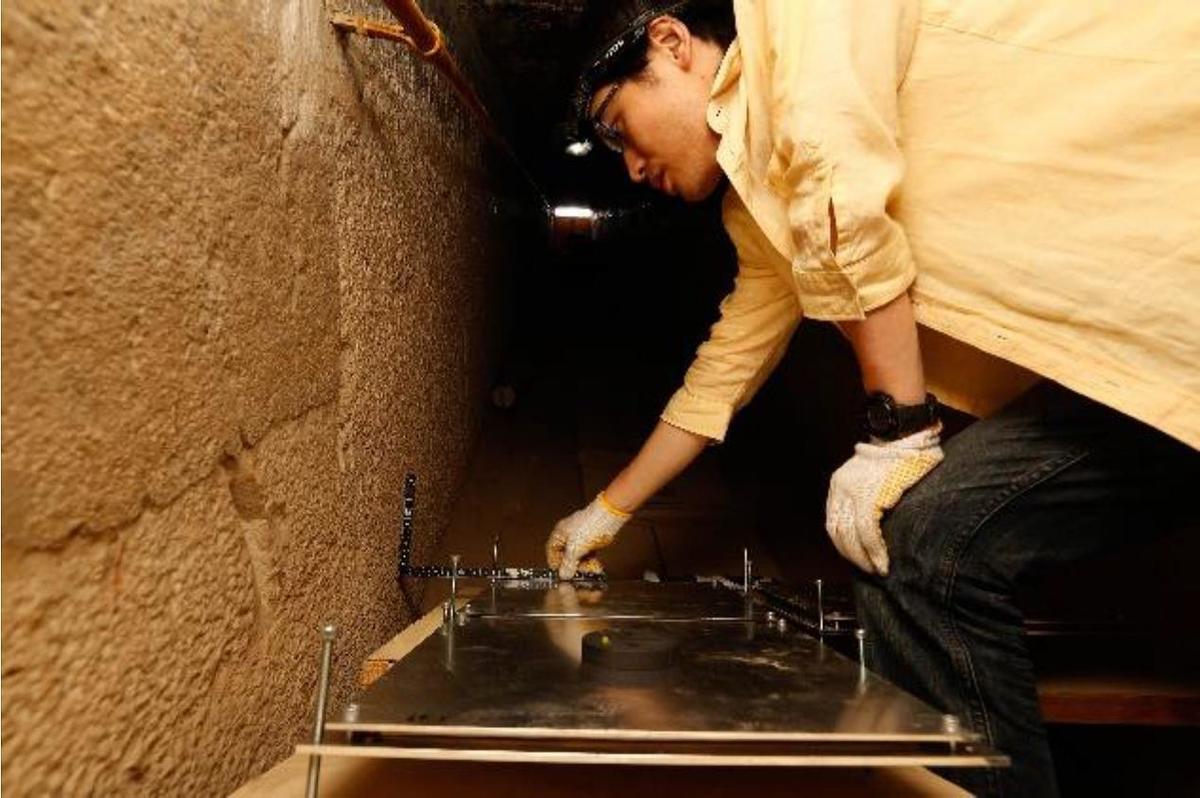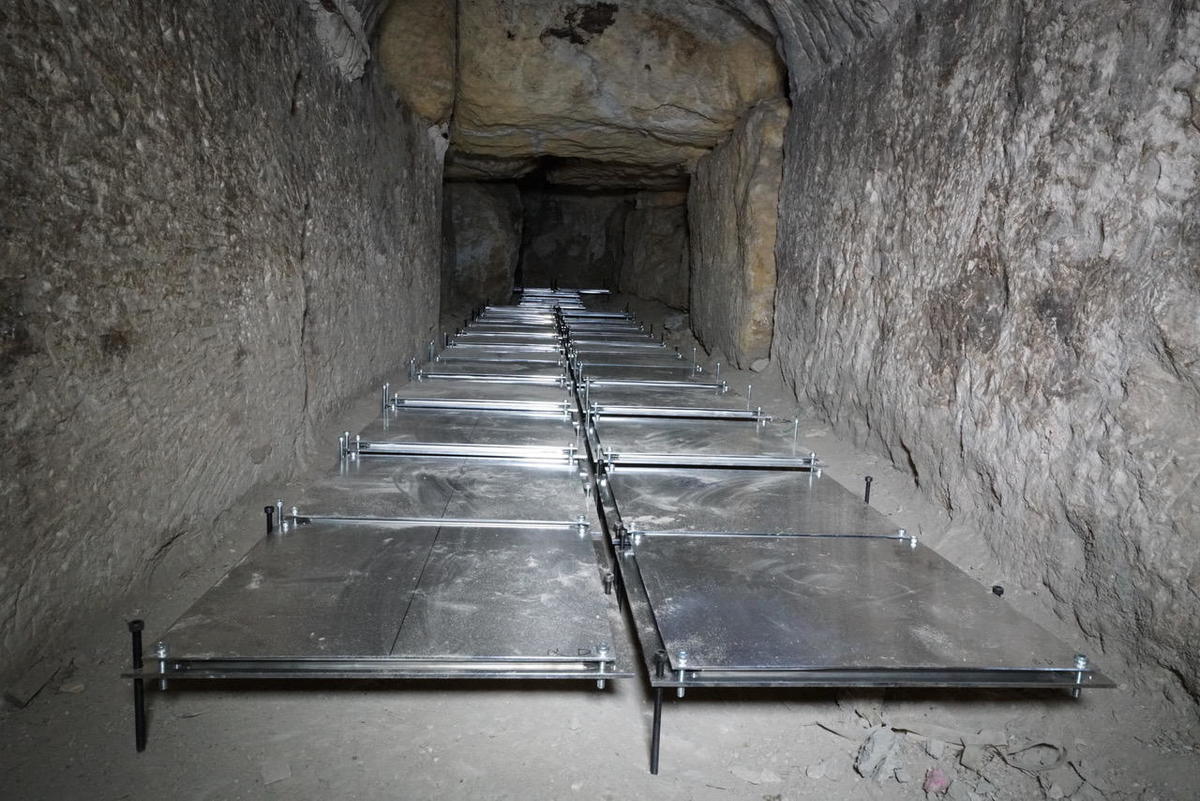November 28, 2017
Reviving Nuclear Emulsion Films
The announcement of research at Nagoya University resulting in the discovery of a huge void inside a pyramid became big international news and garnered much attention recently. If you look behind this discovery you will find the story about nuclear emulsion plates that were used in the discovery -- a story that starts in the past and leads to the future, a story of persistence and a refusal to be beaten by the pyramid. These days a nuclear emulsion plate is a thin piece of plastic, or even just like a photographic film, and now called a nuclear emulsion film. In the world of research, digital systems that detect signals captured in real time and convert them to electrical signals have become mainstream technology, as in the case of Kamiokande (the Kamioka Nucleon Decay Experiment in Gifu Prefecture). As a result, the nuclear emulsion plates have generally fallen into disuse. It is like using an analog film camera in the heyday of the digital camera. But it is actually this "obsolete" technology that hit a homerun this time. In the pyramid research project, this older technology did have digital rivals, but it was so-called low-tech that prevailed, with its advantages of being able to fit into confined spaces and not needing electrical power.
Why the preference for the nuclear emulsion films? They produce high-resolution images. They have the advantage of an overwhelmingly better performance to show things in detail, and this is similar to the strong preference some people have for photographs taken with silver halide films. Meidai also has a tradition of elementary particle research that advanced together with the nuclear emulsion plate and led to the Kobayashi-Maskawa theory, which resulted in a Nobel Prize. Even though manufacturers had stopped production of film, researchers here created a cutting-edge system unrivaled in the world, including equipment to read the film, by learning those technologies through repeated improvements in the lab. These are the reasons Meidai researchers were given the otherwise elusive permission to do the research inside the pyramid.
And now film manufacturers are reportedly paying attention once again to nuclear emulsion films as a technique to peer inside structures. This technique has been used to see inside volcanos and a nuclear reactor at TEPCO's Fukushima Daiichi nuclear power station damaged by an accident. The technique holds great promise, including its use for non-invasive inspections of tunnels, bridges, and other civil engineering structures. It could result in significant business opportunities in the face of concerns about the aging and deterioration of structures like these.
 Pharoah Khufu’s pyramid, where a void was newly discovered
Pharoah Khufu’s pyramid, where a void was newly discovered
So, how does one actually "see" the inside of a pyramid?
"It's like an X-ray image made using cosmic rays," says the research leader, Designated Assistant Prof. Kunihiro Morishima of the Graduate School of Science of Nagoya University. Particles known as muons are among the cosmic rays that arrive here from space, and compared to X-rays used for X-ray imaging, they have a vastly greater ability to pass through objects. The higher their energy the more easily they can pass through dense matter. Similar to how photographic film works, a nuclear emulsion film is placed under the object you want to observe to "expose" it to the muons that pass through. Once the film is developed and the image is analyzed, you can see the distribution of muon-blocking material.
The nuclear emulsion films can produce images at the extremely high resolution of 0.2 microns (one micron is a thousandth of a millimeter). With a charge-coupled device (CCD) in a digital camera, light is received by sensors and converted into electrical signals. If the sensors are small, more can be packed in to increase the resolution of the image, but the smaller they are the less their sensitivity. As a result of that balancing act, a CCD will only have about one-tenth the resolution of a nuclear emulsion film.
As an additional feature, with a nuclear emulsion film it is possible to have a three-dimensional view of the trajectory of particles that have passed through, as the detection layer of film coated with a silver bromide emulsion has a thickness of a few dozen to a few hundred microns. This is another huge advantage over CCD technology and conventional photography, which only display a flat image. "Silver halide film is an old technology, but nothing can compete with it in what you can see," says Morishima explaining his obvious preference.
 Designated Assistant Prof. Kunihiro Morishima showing a nuclear emulsion film
Designated Assistant Prof. Kunihiro Morishima showing a nuclear emulsion film
Nagoya University has a history of research with nuclear emulsion plates spanning more than half a century. The first big achievement was in 1971 with the discovery of the charm quark, one type of elementary particle, by Professor Emeritus Kiyoshi Niu, who passed away in January this year. At the time, only three types of quarks were known, but he discovered something unlike each of them, and named it an X-particle. But he only found one, so the discovery was not widely recognized internationally. It was in 1974 that an American research group discovered this fourth particle using a particle accelerator and named it charm, and for that discovery received the Nobel Prize in Physics in 1976. This discovery also heralded the dawn of the era of particle accelerators.
However, in 1973 Professor Emeritus Makoto Kobayashi of the High Energy Accelerator Research Organization (KEK) and Toshihide Maskawa, Distinguished Professor of Nagoya University, played a major role when they advanced their bold theory of the existence of six quarks. At the time it was still commonly accepted internationally that there were three quarks, but from Prof. Niu's discovery these researchers already knew that there were four. In his acceptance speech for the Nobel Prize in 2008, Prof. Kobayashi praised the research of Prof. Niu as the inspiration for their theory. At last, it is said that he is recognized as the first discoverer of the charm particle.
Meanwhile, it took time to analyze data obtained by telescope using a nuclear emulsion film, so Professor Emeritus Kimio Niwa began at that time to work on developing equipment to automatically digitize and read the data. In 1998, he successfully captured a particle known as the tau neutrino, a world first. After that, he participated in OPERA, a joint European-Japanese international experiment aimed at detecting the tau neutrino, which is created by a phenomenon known as neutrino oscillation. The theory of neutrino oscillation had been advanced by Prof. Shoichi Sakata and colleagues at Nagoya University in 1962. Prof. Yoji Totsuka and Prof. Takaaki Kajita and colleagues at The University of Tokyo were the first to observe atmospheric neutrinos with Super-Kamiokande. Unfortunately, Prof. Totsuka died of cancer, but Prof. Kajita received the Nobel Prize in Physics in 2015 for these achievements. The aim of the OPERA experiment was to observe this phenomenon directly by making neutrinos go from Switzerland to Italy, about 730 kilometers away.
It was Fujifilm that had produced about 12 million films used in that experiment. Subsequently, however, the company stopped manufacturing this type of film. This is why, with guidance from former company personnel, Morishima and other members started making film in the laboratory. It is another big benefit that lab members can make their own emulsions that meet each intended target of observation.
The nuclear emulsion plate could be considered a classical technology, but using cutting-edge systems to exploit its strengths enabled researchers to leap to the forefront internationally. Since the days of Prof. Niu the lab has been known as "F Lab," short for Fundamental Particle Research Laboratory, and it has been expanding its range of research by exploiting the features of nuclear emulsion films.
 Morishima installing the detectors in the confined space. The nuclear emulsion films are sandwiched between two sheets of aluminum.
Morishima installing the detectors in the confined space. The nuclear emulsion films are sandwiched between two sheets of aluminum. Installed nuclear emulsion detectors
Installed nuclear emulsion detectors
One feature is allowing you to see inside structures, similar to X-ray imaging. The pyramid research project described here started with an invitation by NHK (Japan's national broadcaster), a partner of this project, which had noticed the achievements in peering inside a nuclear power plant and in volcano research with nuclear emulsion detectors. Together with KEK from Japan, Nagoya University participated in the international joint research mission called ScanPyramids under the auspices of Egypt's Ministry of Antiquities.
The Meidai team was first to discover a 30-meter-long void inside the pyramid of Pharaoh Khufu. As mentioned, the nuclear emulsion detectors are small and don't need a power source. The ability to fit into a confined narrow space only about one meter wide contributed to the discovery. The KEK equipment captured cosmic rays and converted them to electric signals, but was larger and weighed about 400 kilograms in total. It also required a power source, so there were limitations to where it could be installed. Because of those limitations, the KEK equipment did not find the void with its first observations, but the team tried again after learning about the Meidai team's findings, and could confirm that the void indeed existed.
Going forward, Morishima says he wants to place nuclear emulsion detectors in other locations in the pyramid and investigate the interior further. As new topics, he says he wants to tackle challenges such as observing the movement of iron inside a blast furnace and investigating to see if the furnace walls are getting thinner. A major future theme for the lab is also to unlock the secrets of dark matter, which is currently not well understood, though it is believed to account for about one-quarter of the mass of the entire universe.
"With it we can see things in detail." The technology cultivated by generations of researchers with that conviction is blossoming today. That is one of the big attractions of university research. I hope universities will continue to be a place where more "buds" like these can be nurtured and grown.

 Subscribe to RSS
Subscribe to RSS